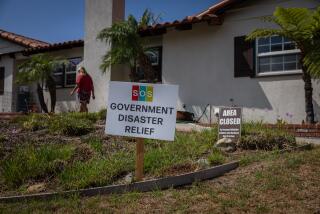Officials Await Decision on U.S. Aid
SAN LUIS OBISPO — Businesses and homeowners remain on tenterhooks in San Luis Obispo County as they await word on whether they will get federal emergency aid, even as county officials say that damages from the 6.5-magnitude San Simeon quake could approach $250 million.
Two women died in the Dec. 22 quake after they were crushed by debris in downtown Paso Robles as they tried to escape a crumbling building. Forty people were injured, and homes and businesses across the region were damaged.
“We have to have federal relief for these people. I can’t imagine what will happen to them if we don’t,” said Ron Alsop, an emergency services coordinator for San Luis Obispo County. “But what we’re hearing back from federal and state officials is that we are very borderline on whether we’ll get it.”
The Governor’s Office of Emergency Services is expected to finish a preliminary damage assessment by the end of this week, a spokeswoman said, when the governor will decide whether to ask the president to issue a federal disaster declaration. Such a declaration is a necessary first step to making millions of dollars of federal aid available to individuals.
Even as Alsop tries to add up the damage for state officials, he said he keeps hearing new estimates. The main San Luis Obispo fire station suffered $500,000 in structural damage. A middle school in Paso Robles may be uninhabitable. And fixing the historic Atascadero City Hall is expected to cost between $10 million and $20 million, officials report.
It has been difficult to get accurate figures, Alsop said. He received reports of 60 mobile homes knocked off their foundations in a Paso Robles mobile home park, for example, only to find that the park was just outside city limits and that the city was unaware of it.
“We’re just afraid that we’re dealing with the perception that because we’re a sparsely populated area, the damage can’t be that bad,” Alsop said. “It’s horrible for us. We know for a fact it will reach $200 million, and we expect in the end it will approach $250 million to bring us back where we were.”
Though Gov. Arnold Schwarzenegger proclaimed a state of emergency in San Luis Obispo County after last week’s temblor, his declaration frees up state funds only for public employee institutions.
“There is no California statute which provides state disaster funds to assist individual homeowners and businesses,” said Sheryl Tankersley, information officer for the Governor’s Office of Emergency Services.
Officials from the Federal Emergency Management Agency said funds from up to 27 different federal agencies can be made available to businesses, homeowners and government institutions if the governor makes the request and it is granted by the president. Officials would not comment on whether they expected that to happen.
Business owners and individual homeowners, who either did not have earthquake insurance or had very high deductibles, are trying to cope in badly hit communities such as Paso Robles, Atascadero, Morro Bay and Cambria.
Meanwhile, as the worst damage in downtown Paso Robles has at least been stabilized, city officials are still wrestling with the stubborn earthquake-induced eruption of a sulfuric mud spring near the site of old mud baths in the City Hall parking lot.
It looks like a small meteor hit the area, as the spring opened up a hole, and construction crews have widened it so they can get heavy equipment down inside.
Emergency crews have been on standby around the clock since the earthquake. City Utility Manager Fred Cardenas said residents will get a partial break from the odor within days as the city tries to channel the half-a-million-gallon-a-day, 111-degree mud into the city’s sewage treatment plan.
He estimates that it could take three to six months before City Hall gets its parking lot back.
Though city officials are trying to maintain a sense of humor, calling it “the hole from hell” and “the employee spa,” it is not surprising to geologists who understand earthquakes.
“If you had told me they had never had sulfuric mud in the past, I’d be surprised,” said Andy Michael of the U.S. Geological Survey.
“But they have a history there,” he said. “And lots of earthquakes open cracks in the aquifers below.”
More to Read
Sign up for Essential California
The most important California stories and recommendations in your inbox every morning.
You may occasionally receive promotional content from the Los Angeles Times.










